Suzanne Pilaar Birch was seven when she caught the archaeology bug on a family trip to Jamestown, Virginia, the first permanent English settlement in the Americas. “Oh this is so cool!” she declared. “I want to come back here and dig.” So when, 24 years later – and now a professional archaeologist based at the University of Georgia and still devoted to digging – she was invited on a field trip in Cyprus, it should have been a no-brainer. Except that she would be six months pregnant on the trip.
It was her first baby, due in August, a child that she’d put off having for eight years because of her career, and she’d vowed not to fly far or do fieldwork that summer. Plus, in more than 10 years working in archaeology (she specialises in analysing animal bones to reconstruct ancient environment and diet), she’d never met a single pregnant woman on a field trip.
“It was irresistible, though,” she says down the phone from Athens, Georgia. “It was a neat project and it had funding and often that’s not the case. I thought, ‘Oh man, how can I say no?’”
Still, she wanted some reassurance that accepting the offer wasn’t crazy. People from outside of her profession were shocked when she told them her plans: “Like, ‘Oh wow! You’d better take care of yourself’.” And googling only turned up a solitary blogpost. “I had nobody to personally contact and ask, “What was it like for you?” she says. So she turned to social media. Fortunately, she had a ready-made online community to ask, having co-founded TrowelBlazers in 2013, a website celebrating female archaeologists, palaeontologists and geologists from history – “awesome trowel-wielding women” – which had grown into a virtual support network of women. So in March this year she tweeted: “Anyone else #pregnantinthefield? How far along were you, how far did you travel, how long was fieldwork? (Maybe even, what did you wear?)”
The responses flooded in. Photos and memories from women with bumps of all sizes, pictured in quarries and temples, jungles and deserts, up mountains and volcanoes, posing with pickaxes, backpacks and clipboards. There are images taken decades ago, pictures from places as far apart as China and Iceland, anecdotes such as: “Walked a 200km pipeline route at 6 months wearing lots of elastic waisted pants.”. And: “Capturing desert iguanas for #science 2 DAYS BEFORE BIRTH!!!”
This bunch of smiling, pregnant scientists, evidently glowing as much from the sheer exertion of hard work as from hormones was a surprising spectacle on Twitter. It was around the time tennis champion Serena Williams announced she was having a baby and the internet was buzzing with the news that she’d won the Australian Open while pregnant – without dropping a set. We frequently see images of glamorous stars showing off their bumps – Beyoncé’s heavily styled Instagram shots, Demi Moore on the cover of Vanity Fair (a pose that Serena Williams herself now replicates for the latest edition of the magazine) – but expectant mums, hard at work?
Pilaar Birch agrees that it’s a rare sight. “Pregnant women [in the media] are always so clean, dressed up nicely, pictured in a yoga pose or something. You never really see them working. In the field there were times when I almost forgot that I was pregnant, I was just doing my thing.”
This is a recurring theme when I speak to the women who contributed photos to the project: they talk about feeling at their most calm and confident in the field. So it’s particularly shocking when Pilaar Birch mentions that a precursor to her hashtag came about after Turkey’s President Erdogan made a speech in 2014 saying women were not equal to men and, as if deliberately to antagonise archaeologists: “You cannot give [women] a shovel and tell them to do their work. This is against their delicate nature.” The hashtag #womendigging rapidly began trending, as women scientists from all over the world defiantly shared pictures of themselves in the field.
The TrowelBlazers site itself was established to counter such sexism after Pilaar Birch and her co-founders (Brenna Hasset, Victoria Herridge and Rebecca Wragg Sykes) found themselves, in 2013, “complaining on Twitter about how women tend to be overlooked in reviews of history or on TV shows about who made discoveries”. They were determined to stop “the casual erasure” of female archaeologists from history. They’ve been blown away by how many women they have discovered and how much these women from the past were supporting one another rather than being “lone wolves” as is commonly believed.
Pilaar Birch believes that the kind of support network TrowelBlazers provides is still crucial in science careers today, partly because men continue to disproportionately get the top jobs and permanent posts. “Male graduates often have supervisors that make sure that they talk to the right people,” she says. “Those networks can be weaker for women.”
And what of Pilaar Birch’s trip to Cyprus? Was it a success?
“It felt so empowering to be there,” she says, adding that the only time she briefly doubted her decision was, ironically, when she took a day off to go to the beach. “I got about 100 bug bites and I was so itchy. I felt really guilty at that moment, like, am I putting my baby at unnecessary risk?”
Now Pilaar Birch is back home and getting excited about her son’s imminent arrival. While she’s obsessed with archaeology, her husband, a teacher, is fascinated by space science. “Between us he’s going to be getting it from all sides!” she laughs. Naturally, though, her greatest fear is that he’s going to arrive before she’s got all of her work done. “I want to get this grant submitted,” she says, “and a couple of articles done, so please don’t come yet… Hold on!”
Ellen Stofan, planetary geologist
California, 1992
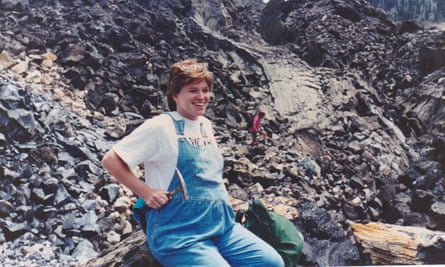
This was our third field studies season at a set of volcanic domes near Mammoth in California. I’d gone up with three colleagues and normally we camped out at the base of the dome but I was six months pregnant with my second child so I said no camping! I was the deputy project scientist on the Magellen Mission to Venus and we were comparing these volcanic domes with some on Venus. They are very steep-sided, huge blocks and tough to work. My co-workers teased me that I look like I was ready to hit one of them. But we’re all still good friends.
The baby in this photo is now 24 and she laughs at it. “Should you really have been doing that, Mom?” But I’m proud of it – for me it’s sort of emblematic that you can have little kids and balance a job. I was chief scientist of Nasa for three and a half years, until I left in December, and when I give public talks about my research I usually mention that I have three kids. It’s important, especially for younger women, to know you can have a family and a career.
Stacey Drake, archaeologist
Belize, 2013
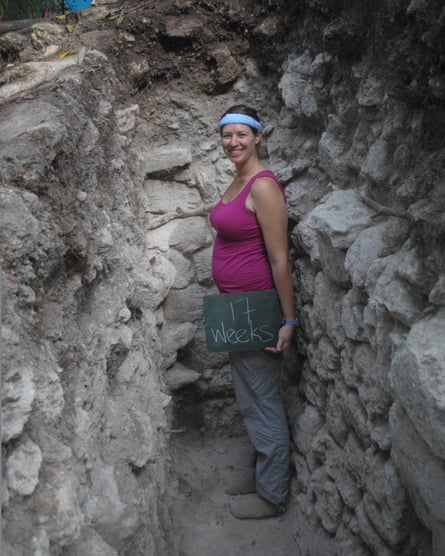
I felt my baby kick for the first time while on this field trip to the jungles of Belize where we were excavating ancient Maya archaeological sites. I specialise in human skeletal remains: if a burial is uncovered, it’s my job to go and make sure that it’s taken care of properly and recorded. You often have to be crouched down in uncomfortable positions and my baby was not enjoying being squished, so I got a really hard kick. She definitely let me know. She’s three and a half now and has been back to the project site at Belize. She likes talking about it.
The things I struggled with most there were probably just the heat and fatigue. One of the sites that I worked required a three-five kilometre walk through the jungle both ways so I gave up on that after a while!
Anjali Goswami, palaeontologist
Argentina, 2016
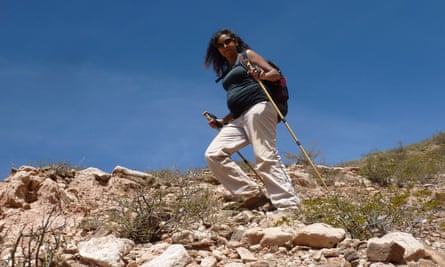
I found a lot more fossils than usual on this trip. I was moving much more slowly so was looking more closely. For my next field crew I’ll try to have all pregnant women! We were in the Salta Basin in Argentina working at high altitudes, 2000-3000 metres up. I felt much better during this pregnancy than the first one, I think because I was slowly hiking for 10km or more a day, not sitting at my desk. There were worrying bits, though. It was so bumpy driving one of the pick up trucks, along river beds a lot of the time, I had to sit on a very padded pillow to stop me bouncing.
The rocks I’m interested in span the period of the last mass extinction of the dinosaurs and we usually work in the basin’s core but those rocks are really high in uranium - not great when pregnant! So we found other sites including this amazing one where we discovered a big dome of fossiliferous rocks with many layers of fish, dinosaurs, crocodiles and turtles.
My son is now ten months and my daughter is four. I’m hoping to bring them with me on our next field trip, next spring. My daughter loves looking for dinosaurs, she has a little junior fossil hunter kit. She’s very excited about Argentina.
Amy Favret, archaeologist
Indiana, 2011
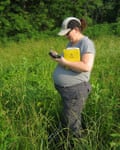
This was probably the hottest day we had that summer and I was working on a contract for the state of Indiana, part of a highway project to mitigate impacts to a creek. The day we took the photo we were joking that we’d put it on the cover of the report. I look at it now and still laugh, it’s so silly.
They don’t make maternity clothes for fieldwork. I had to buy some really large pants to be able to get them over my belly. There was a lot of walking and by the end of the day I was just so tired and dehydrated. I ate nearly half a watermelon on the way out.
My son is almost six now. He’s really into dinosaurs. He’s always doing experiments and digging in the earth. He’s starting just the way I did.
Jennifer Singleton, biologist
California, 2016
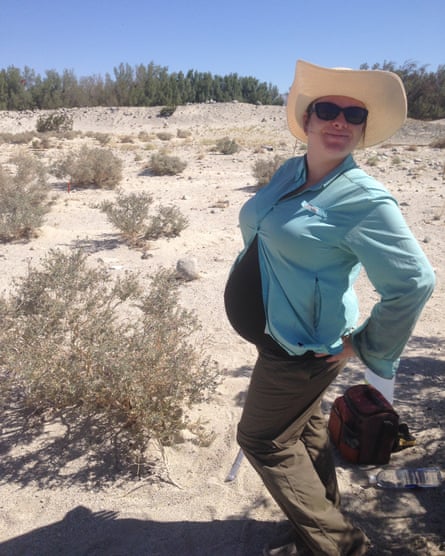
I love this picture. It was taken two days before my son was born, at my field site in the Coachella valley in southern California. My work looks at hormones and behaviour in desert iguanas. When you’re very pregnant it’s hard to feel like you belong anywhere, people stare at you and you can barely walk. But on my field site I felt like myself. Fieldwork makes me feel strong and calm.
I’m currently working on my PhD in biology at the University of California at Riverside and my son is just a year old now. We’ve managed to not put him in childcare yet, I do a lot of evening and weekend work for my PhD. My top tip for working in the field while pregnant would be: don’t lose confidence in yourself. Pregnancy seems to convince you that you can’t do lots of stuff. Safety first, of course, but you’ll be a better mother for following your dreams.
Briana Pobiner, archaeologist
Kenya, 2011
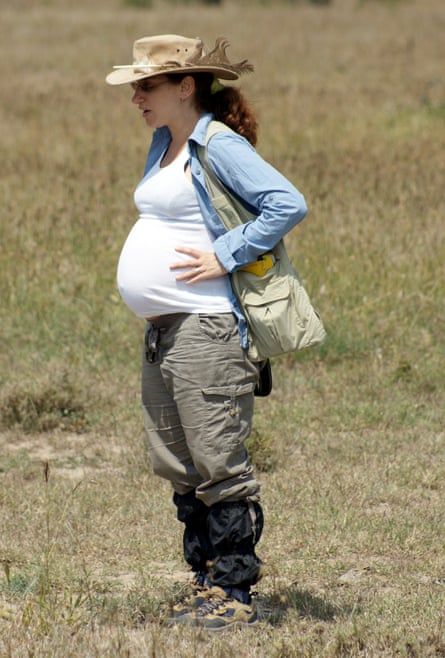
This was my first pregnancy; my son is five now, and I spent my entire second trimester in central Kenya investigating modern animal bones. I work at the National Museum of Natural History at the Smithsonian in the US. I didn’t time my pregnancy so that I could do fieldwork right in the middle of it but I know people who have – I wish I had such control over my reproductive system!
When we got to the reserve, the management said we’re not allowing you to go into the closed, bushy areas because we’re afraid you may not be able to run away fast enough from a dangerous animal. At first I was really irritated, then I thought, actually you probably know more than I do…
Absolutely the worst part of the day there was having to bend over to tie my hiking boots and put on my gaiters every morning. Then in the field I was down, up, down, up, collecting bones. I ended up bringing out a little stool. I felt pretty silly but it was much easier.
ReBecca Hunt-Foster, palaeontologist
Colorado, 2015
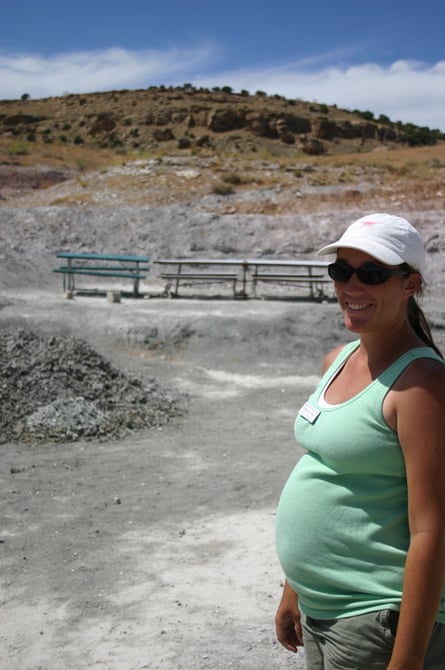
I spent the summer I was pregnant with my first child digging up dinosaurs and giving public tours at a site in western Colorado, a late Jurassic dinosaur quarry called Mygatt Moore. It did become a little difficult to get up and down in the quarry but I actually felt great that summer, really healthy. My daughter is six now – she was born on National Fossil Day.
My husband is a palaeontologist too and our daughter helps us find a lot of really good fossils, she’s got an eye for it. I think we may be raising another palaeontologist. We were going for investment banker – we don’t get paid very much! My advice for anybody wanting to work in the field while pregnant would be listen to your body, you know it best. So many people think they have to stay inside with their feet up, and that’s not always the case. Even after my babies were born I tried to put them in a backpack, go to work and continue with the day.
Karen Masters, astronomer
New South Wales, Australia, 2006
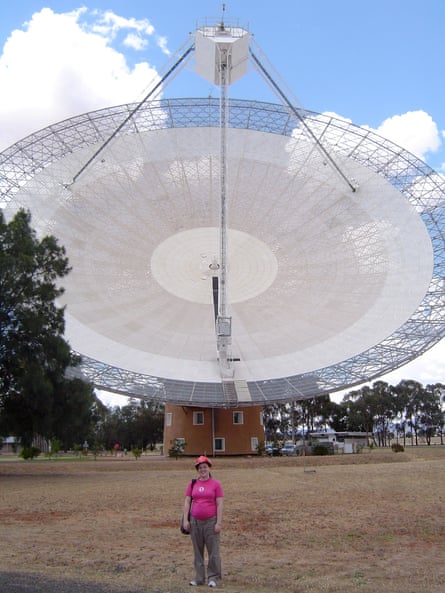
I was about five months pregnant, maybe six, and I was working in a postdoctoral position at Harvard College Observatory [in Massachusetts] when I was invited to go observing at Parkes Observatory in Australia. I remember flying wasn’t very fun: it was such a long flight, very difficult to get in and out of the seat and I got very dehydrated quickly. But, if I remember correctly, I felt the baby kicking for the first time once I was at Parkes. My daughter is nearly 11 now, and finds it funny to see pictures of her as a baby. They recently did “the talk” at school.
You’ll often read advice in this job that it’s not a good time to have children when you’re doing a postdoc. It’s a fixed-term contract, you have to publish a lot and be very active, so women often say they couldn’t have children until they had a permanent position. But I don’t know that I agree with that. I had a postdoc when I had my first child and my second. It’s risky, but there’s never a right time. The time is right when it’s right for you.
With thanks to Faces of Fieldwork, who show the personal side of scientific fieldwork around the world
